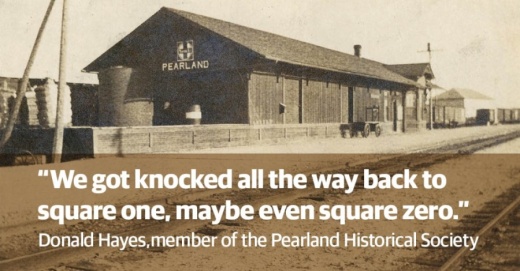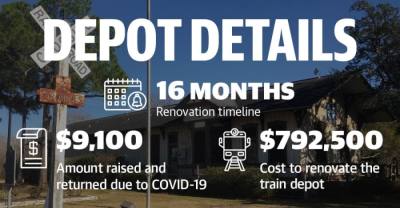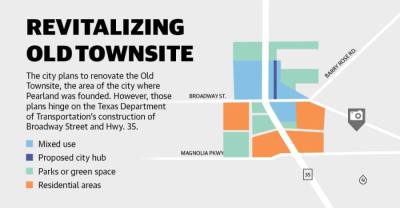“We lost the momentum we worked so long to gain over the last five years,” said Donald Hayes, a member of the Pearland Historical Society.
Hayes was one of the leaders pushing to save the train depot, which has stood in the city since 1900, six years after Pearland was founded. Once the depot, which is in need of restoration, is revitalized, the historical society wants to use it as a museum for Pearland’s history.
Until the train depot is restored, few historical areas remain in the city.
“What else do we have to save?” Hayes asked.
Preserving history
Pearland began as a stop along the Gulf, Colorado and Santa Fe railroad before it became a city. The depot is considered to be the oldest building in the city. It once housed the Pearland Chamber of Commerce and even had been the venue for small events, but it has been vacant since Hurricane Ike hit in 2008.
The Historical Society had the goal to raise enough money to renovate the depot and turn it into a museum, Hayes said. The society also wanted to construct a building behind the depot for office, storage and small event space.
In 2019, the Historical Society gained momentum with a project to sell commemorative bricks to restore the depot. It raised $9,100 through its commemorative brick program, a portion of the $792,500 needed to restore the depot altogether. However, as the funds were collected at the start of the COVID-19 pandemic, Hayes elected to return the money the program raised.
“I felt like it was the right thing to do to return the money we received publicly,” he said.
The Historical Society was also promised $500,000 from the Pearland Convention and Visitors Bureau. Once the pandemic began, that money was reallocated to hoteliers, whose businesses struggled due to COVID-19.
“That was the right move,” Hayes said.
Until the project is prioritized in the city budget again, it is stalled indefinitely, Hayes said.
“We got knocked all the way back to square one, maybe even square zero,” he said.
Council Member Woody Owens is a fan of restoring the depot and plans to bring the item up to council.
Owens is in favor of doing vital repairs on the depot and adding the second building in the future, if funds allow. Repairs—including looking at the foundation, replacing rotten floor boards and painting the exterior—could be done with HOT tax funds, he said.
“If we’re going to do anything, we need to do it now, or that facility is going to continue to deteriorate,” he said.
Owens prefers work be done sooner rather than later, as there are fewer people in Pearland who know the city’s history.
Helen Roberts did not grow up in Pearland but remembers the city when it was primarily rice fields. Roberts owns Antiques, Beads and Crafty People with her daughter, Chawnia Meeks. The business is located down the street from the train depot, which Roberts and Meeks would both like to see preserved, as so many of Pearland’s historical areas have been torn down.
“It’s a shame,” Roberts said. “It was already here.”
Roberts’ family has been in Pearland since 1972; Stella Roberts, the namesake of Pearland’s recycling center, was one of Helen Roberts’ husband’s family members.
Helen Roberts’ oldest daughter had her wedding reception at the train depot. She said building the event center could help the city recoup some of the money it would spend on renovations. As many of Pearland’s historical areas have been torn down, including older houses, Helen Roberts hopes the train depot can be preserved.
Other historical spaces
The city does not have any other historical buildings but does have the Old Townsite, the site where Pearland was originally founded. The city plans to use that land for residential development honoring the history of the area, Community Development Director John McDonald said.
The plan is for the Old Townsite to be developed in a way that echoes historic buildings, McDonald said. However, the city has yet to move forward on what the implementation of the plan would look like, he said.
“It’s about trying to create a walkable, livable district, kind of based on the concepts of early towns but developed for today,” he said. “It will lead to some goals of how we look at new downtown areas in the future.”
The Texas Department of Transportation has plans to widen Broadway Street up to Hwy. 35 in the coming years. This has to be taken into account while planning the development, as it is situated near these roads, McDonald said.
Meanwhile, the depot is deteriorating. While the museum would not bring a lot of revenue to the city, it would bring in tourism, Hayes said.
“I’ve lived here for 22 years, and people complain all the time, ‘There’s nothing to do in Pearland,’” Hayes said. “You have to ask why. Why does a city of 140,000 people, a city of better-than-average income, a city of cultural diversity, not have anything for entertainment?”
Until the city can prioritize a project that may not bring in a lot of revenue to the city, the work on the depot will continue to stall, and Pearland will continue to lack entertainment options, Hayes said.
“There is maybe nothing in it today for us to build this depot, but it’s the tip of the cultural iceberg,” he said.







